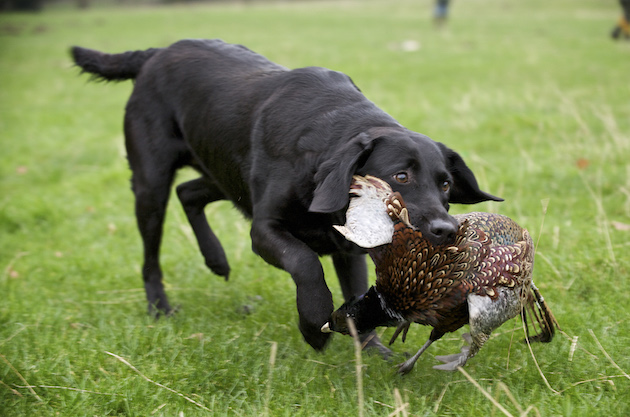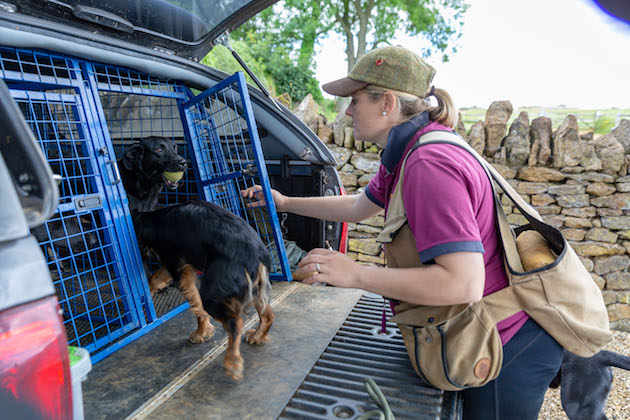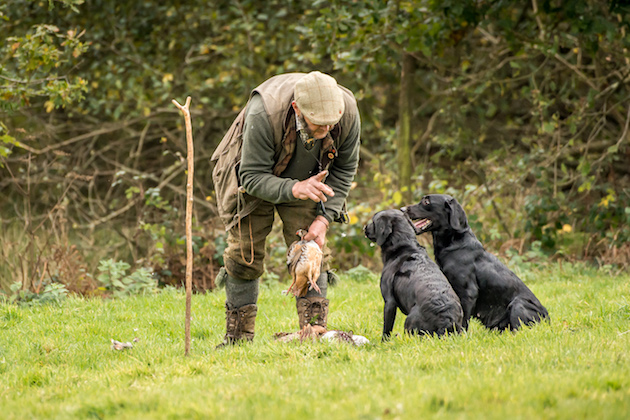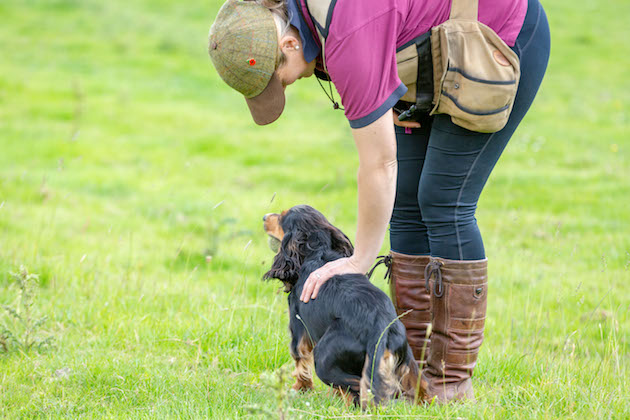Is your gundog ready for its first shoot day?
Rather than ask how old your dog should be, ask yourself the following … Does the dog walk to heel…
Win CENS ProFlex DX5 earplugs worth £1,149 – enter here
 Labrador retrieve
Labrador retrieve
You have decided you are ready to take your young dog on its first day shooting. This is a big deal for any dog and handler, particularly if you are new to training. I often get asked what age is right to take a dog out for their first day. There is no right answer. It is unique to that particular dog.
I have seen dogs out when they are 10 months old and they handle it well. At the other end of the scale, I have seen dogs go out for their first day at 18 months old and it is still too soon. My general rule is if the dog needs to be on a lead in order to keep control, it is too soon. I fully appreciate that a lot of older dogs require leads but to me that simply indicates the basics were not in place and the correct training wasn’t covered.
Sit, heel and recall are the most basic commands to teach a dog. However, it is not uncommon to see these lacking on the shooting field. Not only is it embarrassing for the handler to have an out-of-control dog, the damage they can cause to a drive is likely to result in the owner being sent home by the keeper.
So what should we be considering before we take the plunge on that challenging first day? It is important to remember that in the first season your dog is out, it should not be expected to ‘work’. This may sound odd, but I so often see people out with young dogs expecting them to work as an experienced dog would. All this does is blow their immature mind.

Letting your dogs out of the car to socialise with others will hep to prepare them for a shoot day
If a bird is wounded during a drive and runs while in the open, nothing for a dog creates more excitement. I will nearly always send my older dog for those. It is an easy retrieve as it is obvious which bird I want, easy for the dog to lock on and so no handling required. But if a young dog is sent every time this scenario happens, they will almost certainly start to squeak and run-in. And over time this will get worse. It is much better to let an experienced dog pick those tempting runners efficiently.
In the beating line early on when there are lots of birds on the ground, again I often see people hunting their dogs early in their career. The dog simply gets overwhelmed and ends up either running straight through the drive, or out of control, hunting for itself. The first season out, your sole aim should be that your dog learns in the field, rather than ‘works’. Remember that everything your dog is doing, it is learning.
The scenarios you are giving the dog are totally new so they should all be a success. If the dog learns bad habits on the first day, those will continue. It is much easier to take small steps as you progress rather than taking a big leap and ending up with problems to undo. It takes years to train a good dog and seconds to ruin one.
Another important consideration is whether the dog is physically OK to cope with what the day holds. Beating and picking-up can involve a lot of walking. Young dogs have soft joints that are easily damaged if overused. Injuries are caused when even mature dogs are not fit enough.

Allowing your dog to make a good retrieve, without other dogs trying to steal it, will give it confidence

Ending the day on a positive note will set you both up well for the next outing to a shoot day
A common trigger for a young dog’s overexcitement on a shoot day is the other dogs. They arrive in the morning and dogs are running around, greeting, playing and fighting everywhere. So the more training around other dogs you can do the better. It is vital your young dog can cope with watching other dogs work and run about. You and your dog need to be prepared to watch the good and the bad. There will always be that one dog that is feral, with the handler yelling and whistling, and your dog needs to be able to block that out.
The closest scenario you can get to this without attending a shoot is probably taking them to a game fair have-a-go scurry. There they will hear shot, yelling and shouting commands, dog whistles and often dogs simply running around having a good time. I recently took my young dog to a scurry. As predicted, there was a lot of noise and the dummy launchers excited her. All I asked her to do was walk to heel on a lead and sit calmly and watch. She did this nicely, which was a good start.
On a shoot day it is important your young dog makes the correct associations. It is not the place for playing or fighting other dogs. If you have trained around plenty of dogs, it will help for the youngster’s first day.
Upon arrival at a shoot, I either leave mine in the car or sit them up out of the way where they must simply wait for me. Under no circumstances do they run around ‘free range’. Whether I am beating or picking-up, the dog will only do one or two drives — never a full day.
This is sometimes difficult if you are being transported around on a beaters’ wagon and cannot get back to your car. In that case I would wait until lunchtime to take the dog back home or back to the car so they only do half a day.
Mentally and physically, doing a couple of drives is plenty for a young dog to begin with. My goals are simple; the dog is to walk to heel around dogs, birds and people, and sit/walk calmly during a drive. If they cope with this, I will set up a little scenario to reward the young dog. If beating, I allow it to hunt a small section of cover — as I would in training — where I know it is unlikely that there will be lots of birds or ‘wild’ dogs hunting around them.
I place something as a reward for their hunting near me — again, as I would do in training — such as a ball or even rabbit-skin ball. I practise stop whistle, recall and tight hunting around me. If I am picking-up, I set up a small retrieve as I would in training once the drive has finished and I have picked — with my older dogs — all the birds I need to.
Rather than ask how old your dog should be, ask yourself the following … Does the dog walk to heel…
Getting your dog fit both mentally and physically will help prepare your dog for the field and the rigours of…
Again, I ensure that the scenario is totally controlled. For example, I make sure there are no other dogs around that may try to steal it from the youngster and that my other dogs are all back in from working so I can focus entirely on them.
Throughout the season I increase what the dog is allowed to do little by little. I also increase the time they are out until they stay out for a full day. It is really easy to see how well the young dog is doing and push them to do more. But it is important to understand that a dog can only progress at their pace, not yours.
The more they behave in a positive way on a shoot, the more it becomes habit. However, that works the other way too, so the more often they show undesirable behaviours such as running-in or ignoring the whistle, the more they learn those actions. Never ignore problems — train to correct them. Put the dog into situations that can only help to improve the problem and continue with its homework.
If you have a real success, choose that time to call it a day for the dog. Ending on a good note will set you both up well for the next outing.
Get the latest news delivered direct to your door
Discover the ultimate companion for field sports enthusiasts with Shooting Times & Country Magazine, the UK’s leading weekly publication that has been at the forefront of shooting culture since 1882. Subscribers gain access to expert tips, comprehensive gear reviews, seasonal advice and a vibrant community of like-minded shooters.
Save on shop price when you subscribe with weekly issues featuring in-depth articles on gundog training, exclusive member offers and access to the digital back issue library. A Shooting Times & Country subscription is more than a magazine, don’t just read about the countryside; immerse yourself in its most authoritative and engaging publication.

